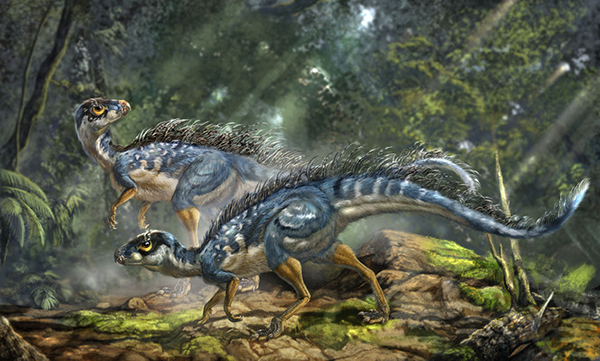
by Brian Fisher Johnson Thursday, January 5, 2012

Bird-hipped_ Tianyulong confuciusi_ may have had "protofeathers." Li-Da Xing
Or so a new fossil discovery might indicate.
While digging in Liaoning Province in northeastern China, paleontologists discovered Tianyulong confuciusi, a petite herbivore that scampered across the forests of the early Cretaceous, about 150 to 100 million years ago. That in and of itself might not be a breakthrough, but the possible “protofeather” filaments on Tianyulong’s spine and tail are. That’s because the new dinosaur is very distantly related to the order of lizard-hipped dinosaurs such as raptors and tyrannosaurs thought to have given rise to birds — possibly forcing scientists to seriously reconsider bird evolution.
Early in dinosaur evolution, the dinosaur family tree split into two main orders: bird-hipped dinosaurs (including Triceratops and Stegosaurus) and lizard-hipped dinosaurs (such as Apatosaurus and Tyrannosaurus rex). Ironically, it is the lizard-hipped lineage which gave rise to modern birds and their evolutionary offshoots, during which time protofeather filaments — small, hollow fibers — evolved into flight-ready feathers.
But Tianyulong is bird-hipped, the first known dinosaur of that order to contain evidence of such filaments (sometimes called “dinofuzz”) in its skin, Xiao-Ting Zheng of the Shandong Tianyu Museum of Nature in China and colleagues reported this week in Nature.
Even though it’s well-accepted that Tianyulong had protofeatherish filaments inside its skin, said Ohio University paleontologist Lawrence Witmer in an accompanying commentary in Nature, what’s not clear is whether these filaments ever pierced the skin’s surface. Whether they were epidermal (extending past the skin, like feathers) or merely dermal (staying inside the skin, perhaps functioning as internal structural fibers) affects whether they likely played a role in bird evolution and the development of flight, he said.
Unfortunately, the fossil may not have been well-enough preserved to reveal whether the chemical signature of keratin, the protein that makes up feathers, was present, as opposed to collagen, the dermal fibers. An alternative test, Witmer wrote, would be to study the structure of the filaments: Protofeathers would be expected to be hollow, while “collagen filaments should essentially be solid.”
But even if scientists can prove that Tianyulong’s filaments are epidermal, scientists would still need to determine whether they are part of the evolutionary lineage of true feathers — or whether they represent the evolution of something altogether different. In the meantime, Witmer wrote, “Tianyulong has made an already confusing picture of feather origins even fuzzier.”
© 2008-2021. All rights reserved. Any copying, redistribution or retransmission of any of the contents of this service without the expressed written permission of the American Geosciences Institute is expressly prohibited. Click here for all copyright requests.